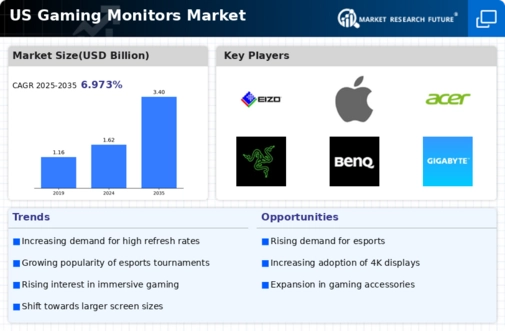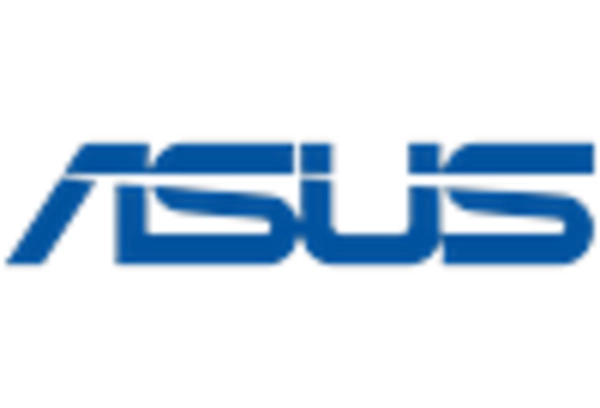Expansion of E-Sports and Competitive Gaming
The rise of e-sports and competitive gaming has become a pivotal driver for the gaming monitors market. With millions of viewers and participants, e-sports events are gaining mainstream recognition, leading to increased investments in gaming infrastructure. High-performance monitors are essential for competitive gamers, as they require low input lag and high refresh rates to enhance gameplay. The e-sports industry is projected to reach a valuation of over $1 billion by 2025, which indicates a robust market for gaming monitors tailored for professional use. This expansion is likely to encourage manufacturers to innovate and produce monitors that meet the specific needs of competitive gamers, thereby stimulating growth in the gaming monitors market.
Increasing Demand for Immersive Gaming Experiences
the market is experiencing a surge in demand as gamers increasingly seek immersive experiences.. This trend is driven by advancements in graphics technology and the growing popularity of virtual reality (VR) gaming. As a result, manufacturers are focusing on developing monitors that offer higher resolutions, faster response times, and enhanced color accuracy. In 2025, the market for high-resolution monitors, particularly those supporting 4K and 8K resolutions, is projected to grow significantly, with estimates suggesting a growth rate of around 15% annually. This increasing demand for immersive gaming experiences is likely to propel the gaming monitors market forward, as consumers prioritize quality and performance in their gaming setups.
Technological Advancements in Display Technologies
Technological advancements in display technologies are significantly influencing the gaming monitors market. Innovations such as OLED and Mini-LED displays are becoming more prevalent, offering superior contrast ratios and color reproduction. These technologies enhance the visual experience for gamers, making them more appealing to consumers. As of 2025, it is estimated that OLED monitors will account for approximately 20% of the gaming monitors market, reflecting a growing preference for displays that provide vibrant colors and deeper blacks. Furthermore, the integration of features like HDR (High Dynamic Range) is likely to enhance the gaming experience, driving further demand for advanced monitors in the gaming monitors market.
Rising Popularity of Streaming and Content Creation
The increasing popularity of streaming and content creation among gamers is emerging as a significant driver for the gaming monitors market. As platforms like Twitch and YouTube Gaming gain traction, gamers are investing in high-quality monitors that not only enhance their gaming experience but also improve their streaming quality. Monitors with features such as built-in webcams, high refresh rates, and low latency are becoming essential for content creators. In 2025, it is anticipated that the segment of monitors designed specifically for streaming will grow by approximately 10%, reflecting the changing landscape of gaming and content creation. This trend is likely to further stimulate the gaming monitors market as more individuals seek to elevate their streaming capabilities.
Increased Consumer Awareness and Preferences for Quality
Increased consumer awareness regarding the importance of monitor quality is driving growth in the gaming monitors market. Gamers are becoming more discerning, seeking monitors that offer superior performance, durability, and features tailored to gaming. This shift in consumer preferences is prompting manufacturers to focus on quality over quantity, leading to the development of premium gaming monitors. As of 2025, it is estimated that the market share for high-end gaming monitors will rise to approximately 30%, indicating a strong demand for products that meet the expectations of serious gamers. This heightened awareness and preference for quality are likely to continue shaping the gaming monitors market, as consumers prioritize their gaming experiences.
















Leave a Comment